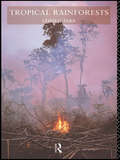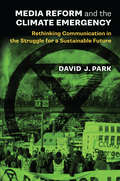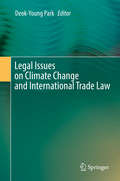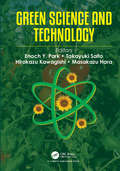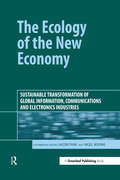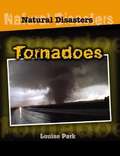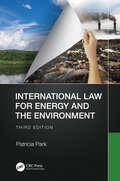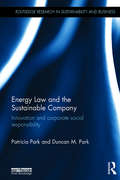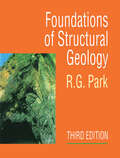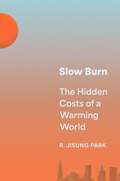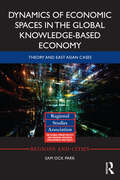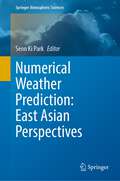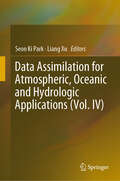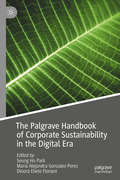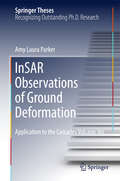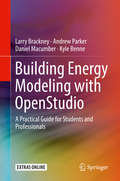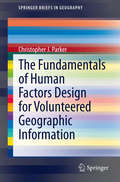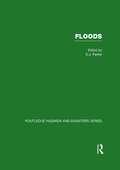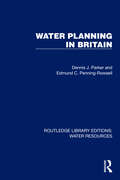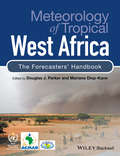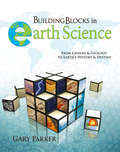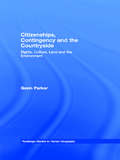- Table View
- List View
Tropical Rainforests
by Chris C. ParkFirst published in 1992. Routledge is an imprint of Taylor & Francis, an informa company.
Media Reform and the Climate Emergency: Rethinking Communication in the Struggle for a Sustainable Future
by David ParkAward-winning author David J. Park argues that the battle against global warming is also a fight for media reform. With his new book Media Reform and the Climate Emergency: Rethinking Communication in the Struggle for a Sustainable World, he critically examines how advertising, the digital infrastructure, and journalism advance the climate emergency and lays out a path of reform to help create a more sustainable world. The production and consumption of goods and services within consumer societies lead to unsustainable greenhouse gas emissions, and Park finds that much of mass communication is either dependent upon or closely tied to the success of this social organization. As a result, he suggests successful environmental movements creatively dismantle or reform institutional infrastructures that extend the planetary global warming crisis and the unsustainable consumption of nature. Communication policies and industries are part of these infrastructures. Advertising evolved to propel a new consumer society that would encourage the over-consumption of goods and services with harmful and unsustainable production processes. Our digital infrastructure is largely premised upon the surveillance of online consumer habits and preferences, with the goal to create individualized messages to more effectively persuade people to increase their consumption habits. Much of commercial journalism resists the drastic and immediate regulatory changes necessary to address the worst aspects of this crisis. This is because so many of the needed changes challenge the media’s source of income, their libertarian philosophy, and the general status quo, which is preferred by elites. Bound to foster conversations among scholars, activists, politicians, and those who work in the communication industries, this book rethinks mass communication and highlights how immediate reform is needed in the struggle for a sustainable planet.
Legal Issues on Climate Change and International Trade Law
by Deok-Young ParkThis book provides anexcellent overview of the legal issues surrounding climate change mitigationand international trade law. It surveys key observed and potential challengesposed by responses to climate change in terms of international trade law. By examiningthe controversial issues seen in legal cases in which domestic climate changeor renewable energy measures conflicted with international trade regimes, thisvolume promotes and broadens the understanding and debate of the issues. Beyondthe recognized challenges, this book uncovers potential areas of conflictbetween climate change responses and international trade promotion by exploringprevious cases and current efforts to prevent climate change. Furthermore, thisvolume sheds light on the future direction of international trade law andclimate change responses, pointing out that the development of climate changeor renewable energy laws and policies must also consider international traderegimes in order to ensure the smooth implementation of said laws and policiesand guarantee that international trade laws do not restrict environmentalpolicy space.
Green Science and Technology
by Enoch Y. Park Takayuki Saito Hirokazu Kawagishi Masakazu HaraThis book provides a comprehensive and up-to-date review of recent trends of green science and technology. Worldwide deterioration of environment and global warming threaten our lifestyle and the survival of all creatures. In order to weather these problems, we need to construct a multidisciplinary approach involving the fusion of various advanced researches. The book begins with an overview on fundamental research about generation and utilization of renewable energy, protection of the earth's ecosystem for better coexistence with nature, development of artificial intelligence-based agriculture and molecular recognitionbased welfare and covers a wide range of innovative research on green science and technology.
Mapping the Chinese and Islamic Worlds
by Hyunhee ParkLong before Vasco da Gama rounded the Cape of Good Hope en route to India, the peoples of Africa, the Middle East, and Asia engaged in vigorous cross-cultural exchanges across the Indian Ocean. This book focuses on the years 700 to 1500, a period when powerful dynasties governed both regions, to document the relationship between the Islamic and Chinese worlds before the arrival of the Europeans. Through a close analysis of the maps, geographic accounts, and travelogues compiled by both Chinese and Islamic writers, the book traces the development of major contacts between people in China and the Islamic world and explores their interactions on matters as varied as diplomacy, commerce, mutual understanding, world geography, navigation, shipbuilding, and scientific exploration. When the Mongols ruled both China and Iran in the thirteenth and fourteenth centuries, their geographic understanding of each other's society increased markedly. This rich, engaging, and pioneering study offers glimpses into the worlds of Asian geographers and mapmakers, whose accumulated wisdom underpinned the celebrated voyages of European explorers like Vasco da Gama.
The Ecology of the New Economy: Sustainable Transformation of Global Information, Communications and Electronics Industries
by Jacob Park Nigel RoomeA "revolution" is taking place in the development of global information and communications technologies. In slightly more than a decade, the World Wide Web has gone from the idea of an obscure English scientist to a consumer-oriented technology system with an expected one billion users by 2005. The technologies that enable this to happen are advancing rapidly, which is leading to both an unprecedented number of start-up companies and a host of innovative new alliances between companies. The growth has been so rapid and unexpected that little research and analysis has yet been done on what impact this transformation has had or will have on the ability of companies to meet the global sustainability challenge. As environmental strategy has traditionally been portrayed in terms of risk cutting and resource efficiency, there is a danger that critical business issues such as information technology, R&D and e-commerce development are examined in isolation from the wider sustainable business perspective. An important objective of the book is to explore, document and raise awareness of sustainability concerns arising from the emerging global information economy. The information economy is defined in the broadest sense possible, including software, hardware, telecommunication – traditional and wireless – and advanced communication technologies. Some of the key issues and questions that are examined include:Case studies on how and to what degree sustainability concerns are being integrated into the business model of electronic, telecommunication and dot.com firms. The relationship between the diffusion of information and communication technologies and the energy and resource intensity of companies. The role of information and communication technologies in the shaping of policies for sustainability, its impacts on sustainable or unsustainable lifestyles and its implications for the interaction between companies and other actors. Corporations and the global digital divide. The Ecology of the New Economy will be of interest to academics, governments, businesses, and non-governmental groups who are trying to understand the linkages and relationship between the two of our greatest global challenges: the information revolution and environmental sustainability.
Natural Disasters Tornadoes
by Louise ParkNatural Disasters: Tornadoes presents the basic scientific principles of how and why tornadoes occur. Case studies of actual events, prevention and warning systems now designed, are both used to show readers the interaction of natural science and human inventiveness .
International Law for Energy and the Environment
by Patricia ParkThis revised edition of Energy Law and the Environment considers how international and national legislation now requires the energy sector to focus more on sustainability and the circular economy in response to new policies at both international and national levels. It explores how environmental law engages with multinational companies regarding energy sources, ownership of those resources, and state sovereignty. Written for all the players in the energy sector, lawyers and non-lawyers alike, this third edition considers the issues of energy sector regulation related to economics and protection of intellectual property associated with the development of technologies for mitigating environmentally damaging emissions. It has been updated throughout and adds new and fully revised chapters on subjects, including climate change, human rights, renewable energy, and energy law in China. Features: Updated throughout and adds new and fully revised chapters Focuses on the global trends and mandates towards environmental sustainability Examines the latest international legislation involving climate change Includes the coverage of oil and gas industries, as well as nuclear and renewable energy
Energy Law and the Sustainable Company: Innovation and corporate social responsibility (Routledge Research in Sustainability and Business)
by Patricia Park Duncan Magnus ParkWhat kind of decision-making should multinationals engage in to create a sustainable company? There is substantial debate over why CEOs, senior management and Boards of Directors make the wrong decisions by not asking the right questions, with the result that not only is the company itself damaged, but all of the stakeholders find themselves at a detriment. Focusing on innovation, technology transfer and the use of intangible assets, Energy Law and the Sustainable Company features case studies from the oil and gas sector, to illustrate how to develop a sustainable business. Considering corporate social responsibility from the perspective of international and national law, the book demonstrates how companies can be both profitable and ethical using the influences of psychology to encourage senior decision makers to make the right decisions. It was revealed that reputation was the main principle influencing decision-making. The book also discusses how companies have reported on their sustainability strategy and considers how technology transfer and intangible assets may play a part in addressing global sustainability. This book should be invaluable reading to students and scholars of Sustainable Business, Business Law, Corporate Social Responsibility, Environmental and Energy Law as well as Environmental and Energy Management.
Foundation of Structural Geology
by R G ParkSince the first edition was published in 1983, this highly-regarded introductory textbook has been used by many generations of students worldwide. It is specifically tailored to the requirements of first or second year geology undergraduates.The third edition has been extensively revised and updated to include many new sections and over 50 new or redrawn illustrations. There are now over 220 illustrations, many incorporating a second colour to highlight essential features. The format has been changed to enhance the visual attractiveness of the book.The tripartite organization of the first and second editions has been modified by combining the purely descriptive or factual aspects of fault and fold structure in the earlier chapters with a simple treatment of mechanisms, leaving the more geometrically complex treatment until after the relevant sections on stress and strain, as before. Some subjects are introduced for the first time, e.g. inversion and orogen collapse, and others have been extensively modified, e.g. the chapter on gravity controlled structures now emphasises modern work on salt tectonics. The last third of the book is devoted to the wider context of geological structures and how they relate to plate tectonics. The final two chapters have been considerably expanded and give examples of various types of geological structures in their plate tectonic settings in both modern and ancient orogenic belts.
Slow Burn: The Hidden Costs of a Warming World
by Robert Jisung ParkHow the subtle but significant consequences of a hotter planet have already begun—from lower test scores to higher crime rates—and how we might tackle them todayIt&’s hard not to feel anxious about the problem of climate change, especially if we think of it as an impending planetary catastrophe. In Slow Burn, R. Jisung Park encourages us to view climate change through a different lens: one that focuses less on the possibility of mass climate extinction in a theoretical future, and more on the everyday implications of climate change here and now.Drawing on a wealth of new data and cutting-edge economics, Park shows how climate change headlines often miss some of the most important costs. When wildfires blaze, what happens to people downwind of the smoke? When natural disasters destroy buildings and bridges, what happens to educational outcomes? Park explains how climate change operates as the silent accumulation of a thousand tiny conflagrations: imperceptibly elevated health risks spread across billions of people; pennies off the dollar of productivity; fewer opportunities for upward mobility.By investigating how the physical phenomenon of climate change interacts with social and economic institutions, Park illustrates how climate change already affects everyone, and may act as an amplifier of inequality. Wealthier households and corporations may adapt quickly, but, without targeted interventions, less advantaged communities may not.Viewing climate change as a slow and unequal burn comes with an important silver lining. It puts dollars and cents behind the case for aggressive emissions cuts and helps identify concrete steps that can be taken to better manage its adverse effects. We can begin to overcome our climate anxiety, Park shows us, when we begin to tackle these problems locally.
Dynamics of Economic Spaces in the Global Knowledge-based Economy: Theory and East Asian Cases (Regions and Cities)
by Sam Ock ParkThis book addresses how economic spaces dynamically change within the context of the global knowledge-based economy. Specifically, it centers the discussion on integrated views of understanding and conceptualizing dynamic changes of global economy under the global megatrends of globalization, knowledge-based economy, information society, service world, climate change, and population aging. Focusing on East Asia, especially on Korea, it deals with case studies regarding the processes and patterns of these global dynamics, looking at economic spaces of various spatial scales and types of economic actors. This book develops a theoretical model for understanding and analysing the dynamics of economic spaces that are being reshaped within the larger global economy. It also emphasizes the analysis of empirical studies at the level of firm, region, and state by considering an evolutionary perspective over time. In developing its theoretical framework, this book examines regional resilience, intangible assets, service innovation, path dependence, and other notions related to the evolution of economic spaces, and incorporates these elements into real-world case studies. The integrated theoretical framework examined here contributes a new perspective on spatial disparities in the global economy. An integral model of service innovation; the integration of path dependence and regional resilience; the interaction between firm and region for the accumulation of intangible assets; and the roles of governments and global firms: these are all essential to understanding the dynamics of economic spaces in East Asia. The theoretical model and case studies in this book suggest policy implications for developing countries, especially in the Asian and African regions, with regard to regional development and innovation policies.
Numerical Weather Prediction: East Asian Perspectives (Springer Atmospheric Sciences)
by Seon Ki ParkThis book describes the history, development, current status of numerical weather prediction (NWP), in both operational and research modes, and various applications of NWP models, which have been made by the scientists in East Asian countries. In particular, it introduces the major contributions to the worldwide NWP community achieved by East Asian scientists, including parameterizations, data assimilation techniques, parameter optimizations, and applications of the NWP models to improve the forecasts of high-impact weather systems in East Asia. This book provides both research scientists and graduate students with basic knowledge and insights on the development of NWP in East Asia.
Data Assimilation for Atmospheric, Oceanic and Hydrologic Applications (Vol. IV)
by Seon Ki Park Liang XuThis book contains the most recent progress in data assimilation in meteorology, oceanography and hydrology including land surface. It spans both theoretical and applicative aspects with various methodologies such as variational, Kalman filter, ensemble, Monte Carlo and artificial intelligence methods. Besides data assimilation, other important topics are also covered including adaptive observations, sensitivity analysis, parameter estimation and AI applications. The book is useful to individual researchers as well as graduate students for a reference in the field of data assimilation.
Principles of Data Assimilation
by Seon Ki Park Milija ZupanskiData assimilation is theoretically founded on probability, statistics, control theory, information theory, linear algebra, and functional analysis. At the same time, data assimilation is a very practical subject, given its goal of estimating the posterior probability density function in realistic high-dimensional applications. This puts data assimilation at the intersection between the contrasting requirements of theory and practice. Based on over twenty years of teaching courses in data assimilation, Principles of Data Assimilation introduces a unique perspective that is firmly based on mathematical theories, but also acknowledges practical limitations of the theory. With the inclusion of numerous examples and practical case studies throughout, this new perspective will help students and researchers to competently interpret data assimilation results and to identify critical challenges of developing data assimilation algorithms. The benefit of information theory also introduces new pathways for further development, understanding, and improvement of data assimilation methods.
The Palgrave Handbook of Corporate Sustainability in the Digital Era
by Seung Ho Park Maria Alejandra Gonzalez-Perez Dinorá Eliete FlorianiThis handbook addresses the intersection between corporate sustainability and digital transformation. It analyzes the challenges and transformations required to be able to have sustainable businesses with a future orientation. Topics include current and potential social, demographic, technological, and managerial trends; the implications of the digital revolution in society and business; as well as the challenges of being sustainable, and profitable. Providing an understanding of the business reasons to incorporate a future orientation into the business strategy, this handbook facilitates an understanding of the need for profound changes in individual behavior, organizational culture, public policy, and business environments to adapt to the accelerated changes and manage business with orientation to the future.
InSAR Observations of Ground Deformation
by Amy Laura ParkerThis doctoral thesis applies measurements of ground deformation from satellite radar using their potential to play a key role in understanding volcanic and magmatic processes throughout the eruption cycle. However, making these measurements is often problematic, and the processes driving ground deformation are commonly poorly understood. These problems are approached in this thesis in the context of the Cascades Volcanic Arc. From a technical perspective, the thesis develops a new way of using regional-scale weather models to assess a priori the influence of atmospheric uncertainties on satellite measurements of volcano deformation, providing key parameters for volcano monitoring. Next, it presents detailed geodetic studies of two volcanoes in northern California: Medicine Lake Volcano and Lassen Volcanic Centre. Finally, the thesis combines geodetic constraints with petrological inputs to develop a thermal model of cooling magma intrusions. The novelty and range of topics covered in this thesis mean that it is a seminal work in volcanic and magmatic studies.
Building Energy Modeling with OpenStudio: A Practical Guide For Students And Professionals
by Andrew Parker Larry Brackney Daniel Macumber Kyle BenneThis textbook teaches the fundamentals of building energy modeling and analysis using open source example applications built with the US DOE’s OpenStudio modeling platform and EnergyPlus simulation engine. Designed by researchers at US National Laboratories to support a new generation of high performance buildings, EnergyPlus and OpenStudio are revolutionizing how building energy modeling is taught in universities and applied by professional architects and engineers around the world. The authors, all researchers at National Renewable Energy Laboratory and members of the OpenStudio software development team, present modeling concepts using open source software that may be generally applied using a variety of software tools commonly used by design professionals. The book also discusses modeling process automation in the context of OpenStudio Measures—small self-contained scripts that can transform energy models and their data—to save time and effort. They illustrate key concepts through a sophisticated example problem that evolves in complexity throughout the book. The text also examines advanced topics including daylighting, parametric analysis, uncertainty analysis, design optimization, and model calibration. Building Energy Modeling with OpenStudio teaches students to become sophisticated modelers rather than simply proficient software users. It supports undergraduate and graduate building energy courses in Architecture, and in Mechanical, Civil, Architectural, and Sustainability Engineering.
The Fundamentals of Human Factors Design for Volunteered Geographic Information
by Christopher J. ParkerThis book explores the roles in which volunteered and professional information play within neogeography from a human factors perspective. The unique advantages of each information type are considered alongside how they may be utilised to create products and services delivering highly functional, efficient and satisfying experiences to their users. The overall aim of this book is to address the issue of how Volunteered Geographic Information (VGI) can be combined with Professional Geographic Information (PGI) to satisfy the information search requirements of consumer-users via highly usable mashups. Firstly, this required the development of an understanding of the way different users perceive VGI and PGI in terms of its benefits to their activities and information needs. Secondly, the benefits that VGI may bring to the user experience of a mashup (which cannot be attained through the use of PGI) needed to be understood. In order to achieve this, a user centred design perspective was implemented throughout the research.
Floods: British Policies For Hazard Reduction, Agricultural Improvement And Wetland Conservation (Routledge Library Editions: Conservation Ser. #5)
by D. J. ParkerFloods occur in most parts of the world and range from being welcomed annual occurrences, to natural disasters which have countless physical and societal impacts. Floods presents the most comprehensive collection to date of new research, providing a rich body of theory and experience and drawing together contributions from over fifty leading international researchers in the field. An extensive range of case-studies covering major floods and regions prone to flooding worldwide are included.
Water Planning in Britain (Routledge Library Editions: Water Resources)
by Dennis J. Parker Edmund C. Penning-RowsellOriginally published in 1980, this book provides a penetrating and scholarly analysis of the planning of water resources, based on 10 years’ of research into one of Britain’s most vital industries. At the time of original publication Britain had a plentiful natural supply of water, but accessible clean water was scarce; droughts were not uncommon, floods often caused considerable damage; water bills were rising dramatically and consumption increasing inexorably. All of which applies as much to water resources in the UK today. Water planners must strike a delicate balance between many conflicting social, environmental, political and financial demands. Britain’s water authorities are large and autonomous organisations subject to constant change and controversy. Water policies affect not only water but also land-use planning, recreation planning, environmental quality, food production and the maintenance of public health. The book explains common threads and issues in the planning of 4 main water functions: water supply, effluent disposal and pollution control, water recreation and amenity and land drainage and flood alleviation. 11 original British case studies have been selected to illustrate the issues involved. The final chapter presents a critical and controversial evaluation of water policy and planning institutions in Britain, highlighted by some international comparisons.
Meteorology of Tropical West Africa: The Forecasters' Handbook
by Douglas J. Parker Mariane Diop KaneMeteorology of tropical West Africa: the Forecasters’ Handbook presents the science and practice of weather forecasting for an important region of the tropics. Connecting basic theory with forecasting practice, the book provides a unique training volume for operational weather forecasters, and is also suitable for students of tropical meteorology. The West African region contains a number of archetypal climatic zones, meaning that the science of its weather and climate applies to many other tropical regions. West Africa also exhibits some of the world’s most remarkable weather systems, making it an inspiring region for students to investigate. The weather of West Africa affects human livelihoods on a daily basis, and can contribute to hardship, poverty and mortality. Therefore, the ability to understand and predict the weather has the potential to deliver significant benefits to both society and economies. The book includes comprehensive background material alongside documentation of weather forecasting methods. Many examples taken from observations of West African weather systems are included and online case-studies are referenced widely.
Building Blocks in Earth Science
by Dr Gary ParkerDevelop critical thinking skills as you explore what to believe and why you believe it! To understand earth science, it requires "teamwork," combining the methods and evidences of both science and history. And if you also use the "history book of the world," the Bible, you can make sense of the Earth's surface -- altered, formed, and weathered over time, the landscapes and vistas we enjoy today. Learn about the: Structure of the Earth and its atmosphere. Types of minerals and rocks, the water table, and types of volcanoes Earth's tornadoes, faults, polarity, magnetism, reeds, folding, hypercanes, deltas, and much more! When you understand the difference in history and science in questions related to our planet, you can more effectively discern the evidences seen in the world around you. Science is an awesome tool for understanding the workings of our world and for applying such knowledge to benefit mankind. "Scientific truth" however is not determined by consensus, compromise, majority vote, popularity, celebrity endorsement, money, media endorsement, or best-selling books -- and it is at its best when it is rooted in a worldview that begins with the Bible!
Building Blocks In Earth Science: From Genesis And Geology To Earth's History And Destiny
by Gary ParkerDevelop critical thinking skills as you explore what to believe and why you believe it! To understand earth science, it requires “teamwork,” combining the methods and evidences of both science and history. And if you also use the “history book of the world,” the Bible, you can make sense of the Earth’s surface — altered, formed, and weathered over time, the landscapes and vistas we enjoy today. Learn about the: - Structure of the Earth and its atmosphere. - Types of minerals and rocks, the water table, and types of volcanoes - Earth's tornadoes, faults, polarity, magnetism, reeds, folding, hypercanes, deltas, and much more! When you understand the difference in history and science in questions related to our planet, you can more effectively discern the evidences seen in the world around you. Science is an awesome tool for understanding the workings of our world and for applying such knowledge to benefit mankind. “Scientific truth” however is not determined by consensus, compromise, majority vote, popularity, celebrity endorsement, money, media endorsement, or best-selling books — and it is at its best when it is rooted in a worldview
Citizenships, Contingency and the Countryside: Rights, Culture, Land and the Environment (Routledge Studies in Human Geography #Vol. 2)
by Gavin ParkerCitizenships, Contingency and the Countryside defines citizenship in relation to the rural environment. The book expands and explores a widened conceptualization of citizenship and sets out a range of examples where citizenship, at different scales, has been expressed in and over the rural environment. Part of the analysis includes a review of the political construction and use of citizenship rhetoric over the past 20 years, alongside an historical and theoretical discussion of citizenship and rights in the British countryside. The text concludes with a call to recognise and incorporate the multiple voices and interests in decision-making, that all affect the British countryside.
